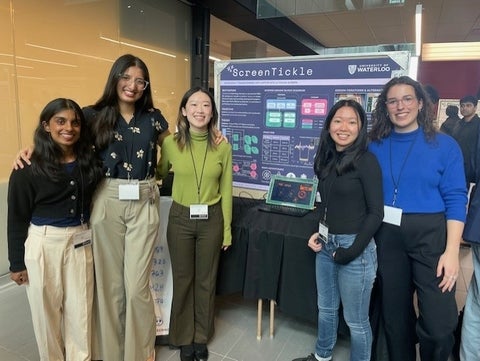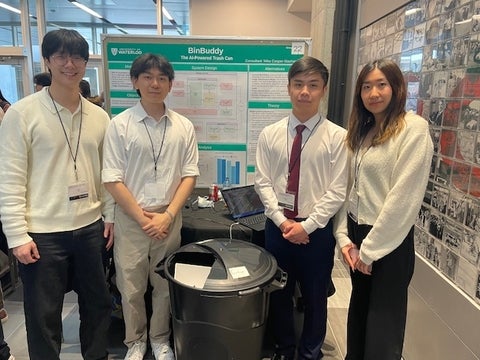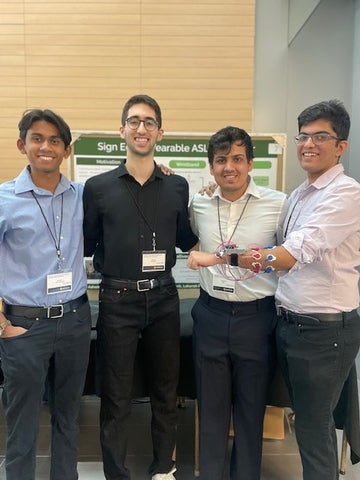Each year, the University of Waterloo’s Electrical and Computer Engineering (ECE) Capstone Design program turns the bold ideas of its final-year students into innovations that shape the future. This highly anticipated event is more than just an academic milestone—it's a launchpad for cutting-edge technology, where creativity meets real-world problem-solving. From next-generation hardware to AI-powered solutions, Capstone projects push the boundaries of what’s possible, showcasing the ingenuity, technical skill, and entrepreneurial spirit that defines Waterloo engineers.
At this year’s Capstone Design Symposium, seven standout projects captivated judges and attendees alike—two of which clinched top honors, presented on April 1st during the Electrical and Computer Engineering Grad Toast event. This memorable celebration united students, faculty, and staff to honor the graduating class of 2025. Dr. Kankar Bhattacharya, Professor and Chair of the Department, shared his pride in the students' achievements, stating,
“Over the past five years, everything you’ve learned in the classroom and through your co-op work terms came together to create something truly relevant and impactful. The Capstone Design project was the pinnacle of that journey, offering you the opportunity to bring your skills to life. Each of you pushed your boundaries, demonstrated creativity, problem-solving skills, and technical expertise. As a department, we are incredibly proud of the outstanding designs and solutions you’ve all developed.”
Meet the teams and their inspiring projects shaping the future of technology:

Winners of the ECE Capstone Design Project Prototype Excellence Award.
ECE Capstone Design Project Prototype Excellence Award
This award recognizes a team that successfully transforms an innovative idea into a functional prototype.
Winning Project: ScreenTickle
Team: Irene Boby, Wani Gupta, Subin Lee, Ella Smith, Kristin Wu
The team behind ScreenTickle has pioneered an innovative, attachable touch-enabled frame that turns any non-touchscreen device into a fully interactive touchscreen. Using advanced infrared (IR) sensors and photodiodes, the system creates an invisible grid of IR light beams to detect touch inputs, wirelessly connecting to a computer. Inspired by their own experiences as students seeking interactive note-taking solutions, the team leveraged IR technology to develop a cost-effective touch interface. This breakthrough offers a game-changing, affordable alternative to expensive touchscreen hardware, unlocking new possibilities for users without the hefty price tag. Overcoming challenges like manual assembly and multi-touch implementation, they successfully integrated essential touch gestures, including tapping, dragging, scrolling, and zooming.
While the team has no immediate plans to commercialize ScreenTickle, they take pride in their innovative approach and the technical skills they've honed throughout the project. As they complete their undergraduate studies, they are excited to pursue careers in the industry.
ECE Capstone Design Project Technical Excellence Award
This award honors a team that demonstrates outstanding technical analysis, complexity, and problem-solving.
Winning Project: Analog Intelligence
Team: Alfonso Faria Espinoza, Timothy Gao, Jorge Marcano, Cameron Mears, Griffon Thomas, Ivan Zhang
Current neural network signal processing typically involves quantizing signals both spatially and temporally before inference. This process requires converting large amounts of input data before feature extraction, which increases latency and computational inefficiency. In response, the team developed the Analog Neural Signal Processing Unit. This printed circuit board integrates both digital and analog circuits to perform inference directly in the analog domain using continuous signals. By shifting quantization to the feature level rather than the input stage, this approach reduces the need for heavy computation, saving space, time, and energy.
The project shows strong potential for commercialization, with a design that is scalable beyond the prototype phase. The team is exploring opportunities to bring the technology to market. This collaborative effort has been both challenging and rewarding, highlighting the power of teamwork in driving innovation forward.
As the team prepares for life after graduation, most are focusing on careers in the tech industry, with some considering academia or travel before making their next move.

Winners of the ECE Capstone Design Project Technical Excellence Award

Project: BinBuddy
Project: BinBuddy
Team: Yang Lu, Benson Shen, Jennifer Wang, and Jun Zheng
BinBuddy is an innovative AI-powered waste-sorting system designed to transform how we address the growing environmental crisis of improper waste disposal. By using artificial intelligence and computer vision, BinBuddy automates the process of classifying waste into recycling, compost, or garbage. This technology aims to reduce contamination in recycling streams, a problem where nearly 25% of recyclables in North America are disposed of improperly. The system captures an image of each item, sends it to an AI model, and instantly sorts it into the correct compartment—offering a faster, more accurate solution than traditional manual sorting.
The team’s capstone project involved extensive research and collaboration, with separate focuses on mechanical design and AI model optimization. The result is a functional prototype that sorts waste in real time, featuring a user-friendly interface. While the team does not plan to commercialize the product immediately, they are excited about its potential applications in homes and public spaces.
Project: Book-to-Movie
Team: Chinemerem Chigbo, Atharva Gangal, Keyon Jerome, James Jiang, Orson Marmon
Imagine stepping into the world of your favorite book, not just through words, but with vibrant visuals, sound, and interactive elements. Book-to-Movie (B2M) is a system that combines cutting-edge AI with advanced book-scanning technology to transform both physical and digital books into dynamic multimedia experiences. By integrating AI-powered text-to-speech, image generation, and text segmentation, B2M enables authors to turn their books into high-quality, video-based stories that are more engaging and accessible. The system automates the scanning of pages and processes the text to generate visuals, assign character voices, and create an animated, audiobook-like format.
Initially designed to help authors convert books into affordable audiobooks, the project has evolved into a solution with broader commercial and social implications. B2M has the potential to transform society by offering an immersive and accessible format for individuals with learning disabilities and other diverse needs, while enhancing the experience of literature for all readers. While the prototype is functional, future iterations could include full animation and even greater accessibility. With the possibility of commercialization, the team’s innovation—fostered in Waterloo’s hands-on learning environment—seeks to revolutionize storytelling.

Project: Book-to-Movie

Project: OpenCore
Project: OpenCore
Team: Joey Chen, Ryan Erler, Alexander Novoselsky, Jason Skells, Ari Wasch
Introducing OpenCore – a groundbreaking open-source GPU design created to disrupt the dominance of proprietary giants like NVIDIA and AMD. OpenCore offers a fully customizable and accessible graphics processing unit architecture, empowering hobbyists, researchers, and developers to break free from the limitations of closed-source systems. Built on AMD’s RDNA 2.0 instruction set architecture (ISA) and implemented on an FPGA with a custom PCB, this innovative design invites users to modify, optimize, and tailor the GPU to their specific needs, whether for high-performance gaming or cutting-edge AI research.
The team faced many challenges to bring OpenCore to life, but their perseverance turned those obstacles into stepping stones. By embracing the power of open-source, they’ve unlocked limitless potential for innovation, allowing users to shape and refine GPU designs, which could fuel future commercial applications and technological breakthroughs. As graduation approaches, the team reflects on the strength of their collaboration, recognizing how both industry experience and academic insight played crucial roles in their success.
Project: Sign Echo
Team: Ashwin Boni Bangari, Ritik Chanchlani, Daniel Markovic, Bassel Al Omari, Lokansh Rai, Muhammad Tanveer
Sign Echo is a revolutionary wristband designed to break down communication barriers for American Sign Language (ASL) users. This innovative wearable device translates ASL gestures into spoken English through a mobile phone speaker, offering a solution to the challenges faced by the Deaf and Hard of Hearing (DHH) community. By utilizing Inertial Measurement Unit (IMU) and electromyogram (EMG) sensors to capture hand movements and muscle activity, Sign Echo transmits real-time data to a mobile app, where a machine-learning algorithm processes and translates the signs, enabling seamless communication in both social and professional settings.
Inspired by a personal connection to ASL, the team set out to create a device that empowers ASL users to communicate more effortlessly and integrate into society. Throughout the project, they collaborated closely with the university's ASL Club, refining their design to ensure it met the needs of the community. Though still in the proof-of-concept phase, Sign Echo’s potential for future iterations with enhanced capabilities is clear, and the team is exploring commercialization opportunities. This project exemplifies the power of engineering innovation in creating a more inclusive and accessible world for ASL users.

Project: Sign Echo
Project: Spice-it
Team: Duke Gand, Veer Khurana, Nick Lam, Kehn Saplagio
Spice-it is an innovative automatic spice dispenser created to simplify cooking for home chefs. With just the push of a button, it dispenses precise amounts of spice—down to a quarter-teaspoon—eliminating the hassle of measuring and pouring. Whether you’re a beginner or an experienced chef, Spice-it ensures perfect seasoning every time and lets you save your favorite recipes for quick, repeatable use.
Built with custom-designed components, including a specially crafted PCB and 3D-printed parts, Spice-it is the product of a hands-on, dedicated team. In its current form, the dispenser features a rotating funnel system that holds a variety of spices and dispenses them accurately into your cooking container. But the innovation doesn’t end there—the team is exploring future upgrades, like integrating artificial intelligence to suggest recipes and automatically dispense the right spices while you cook.
Though still in its early stages, the team is focused on refining the design and enhancing both materials and functionality. With its potential to revolutionize the kitchen, Spice-it promises to make cooking easier, smarter, and more enjoyable.

Project: Spice-it
On the eve of graduation, these students are not just displaying their technical expertise—they are proving they are ready to make a real-world impact. With their sights set on the future, these Capstone innovators are leaving Waterloo with more than just degrees; they are carrying forward ideas that have the potential to transform industries, solve global challenges, and shape the next generation of technology.